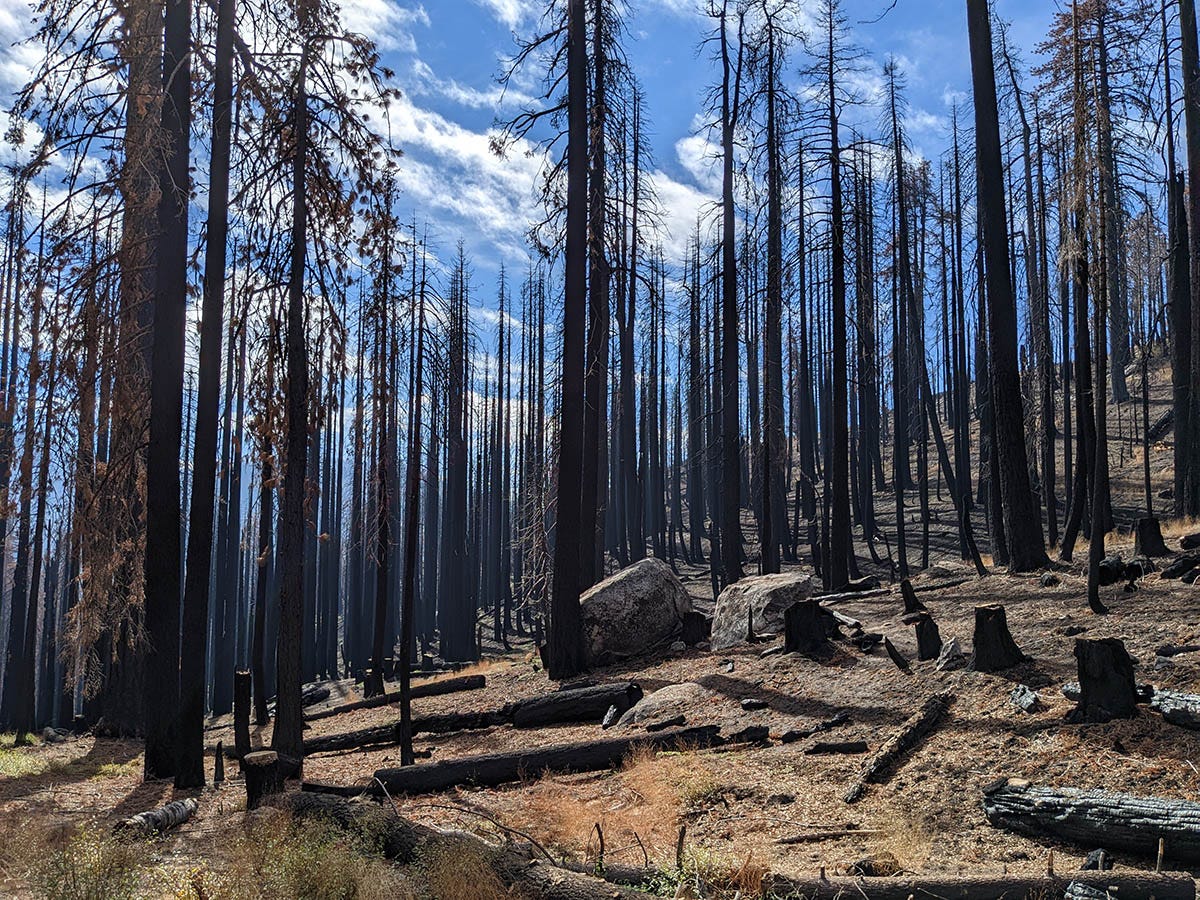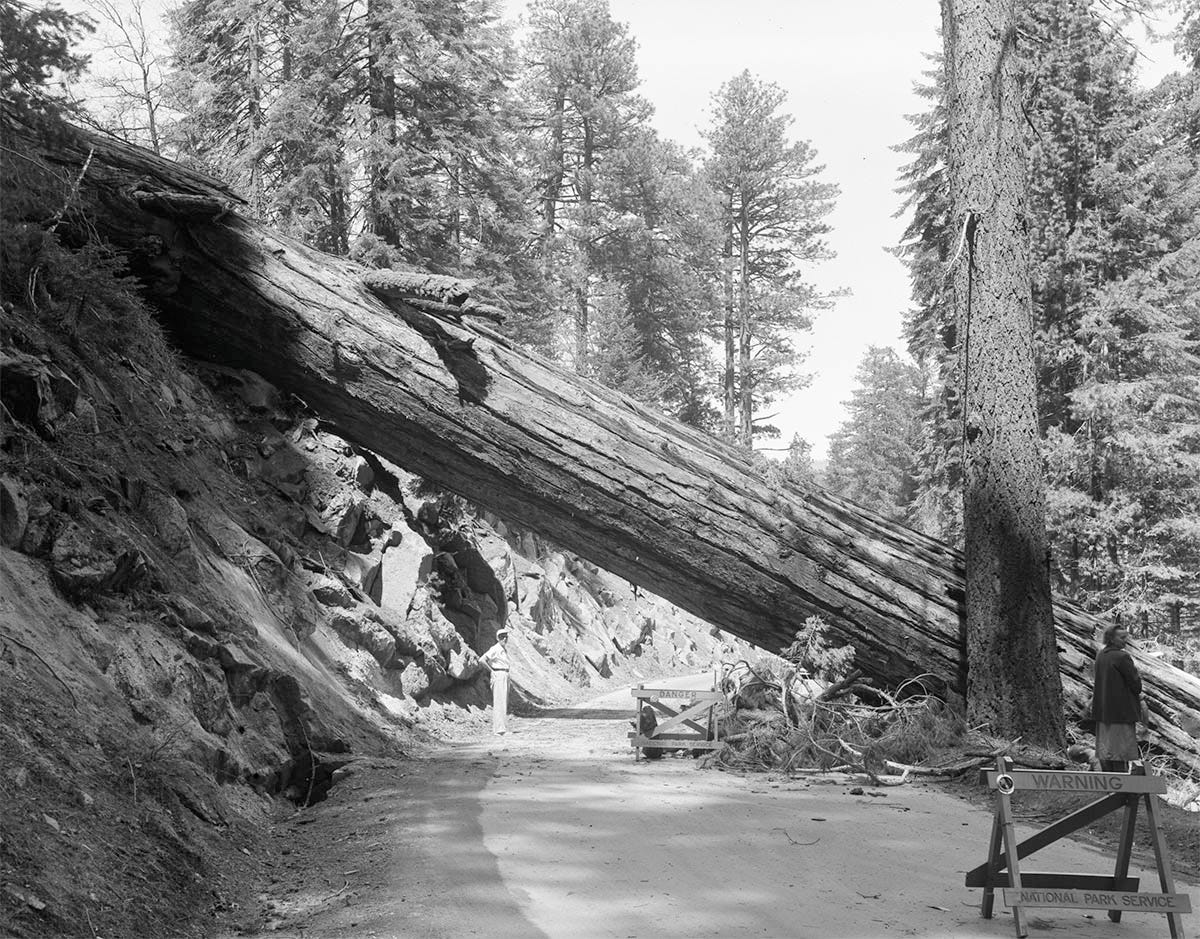Giant sequoia loss is ‘a national disgrace’
Author asks what would John Muir think of fiery deaths of trees?
Volume 1, Number 18 - Monday, Dec. 5
Standing dead trees in the vicinity of the border between Sequoia National Park and the Hume Lake Ranger District of Sequoia National Forest, November 2022. — Claudia Elliott
Perspective
I READ WITH GREAT INTEREST an article published in the latest edition of Range magazine entitled “What we are witnessing is a national disgrace! The needless destruction of national treasures.”
The author is Jim Petersen of the Evergreen Foundation, an organization he founded in 1986 “to advance fact-based information about forestry and forest management” — and he’s writing (mostly) about giant sequoias.
Among books I’ve read recently is Petersen’s “First put out the fire — rescuing western national forests from nature’s wildfire pandemic,” which was published in 2020.
Range magazine is a quarterly magazine “devoted to the issues that threaten the West, its people, lands and wildlife” — and celebrating the cowboy spirit.
I mention these things because I recognize that Petersen and Range magazine come to the table with a certain perspective.
I also recently read another book, Chad T. Hanson’s “Smokescreen, debunking wildfire myths to save our forests and our climate,” published in 2021. Hanson is director of the John Muir Project of Earth Island Institute and I think I’m being fair if I also describe him as among the leading litigants over issues of management of public lands on which giant sequoias grow.
If I were to draw a graph showing the range of opinions about forest management, I’d say that Hanson and Sierra, the magazine of the Sierra Club, would be on the left and Petersen and Range magazine on the right.
I’m not sure there really are any people in the middle. But in my work as a journalist, I try to inform myself about the range of opinion and avoid advocacy (although I’m not sure that’s actually possible because I imagine I subconsciously promote positions that make sense to me over those that do not).
So, all of that said, back to Petersen’s article, which I encourage you to read for yourself…
He writes about an area I know well — the southern Sierra Nevada. It’s here that John Muir came across the giant sequoia groves that he described as the finest of them all. And also here that thousands of the mammoth trees have been lost in wildfires during the past few years.
Among the people Petersen talked to for the article were Del Pengilly of Springville. Pengilly is now retired, but when I met him in 2000 he was District Ranger of what was the Tule River-Hot Springs Ranger District — now known as Western Divide Ranger District — of Sequoia National Forest.
Another of Petersen’s sources was Kent Duysen of Sierra Forest Products. The company’s lumber mill in Terra Bella, north of Bakersfield, is the only substantial lumber mill in the southern half of California. The company’s mill about 60 miles to the north in Dinuba was closed in 2000 after Giant Sequoia National Monument was created. And the lack of lumber mills in the state has become a concern as land managers try to figure out how to “unload the trees that worsen … wildfires,” according to a Sacramento Bee article last year.
During the time that I published the now-defunct Southern Sierra Messenger newspaper, I learned a lot from Pengilly, Duysen and other members of the Society of American Foresters who lived and worked in the area. I found them to be thoughtful, honest people.
Petersen also writes about the Sierra Club and in particular the chairperson of the Sierra Club’s Sequoia Task Force, who he doesn’t name but is likely known to anyone who has followed Sequoia National Forest issues through the years.
I haven’t seen the three-page memo he references, but I do recall a Sierra Club member stating in a public meeting that the giant sequoia trees didn’t need help from the Forest Service because they won’t burn — in fact, that in case of a wildfire, a giant sequoia grove would be the safest place to be.
Famous. Last. Words.
Petersen also shared something Muir wrote in an essay for the Atlantic Monthly in 1897: “Any fool can destroy trees. They cannot run away; and if they could, they would still be destroyed — chased and hunted down as long as fun or a dollar could be got out of their bark hides, branching horns or magnificent bole backbones. Few that fell trees plant them; nor would planting avail much towards getting back anything like the noble primeval forests.”
And here’s what Petersen asked about Muir: “What would he say about the death and destruction the Sierra Club Task Force chair and her colleagues have caused in forests they profess to love? Does their hatred for forest management have any limits? It doesn’t seem so. What would Muir think about the Sierra Club’s willingness to allow his giant sequoias to die fiery deaths?”
When the Forest Service — and later the National Park Service — announced their emergency action for giant sequoias this summer, I was hoping some consensus about the management of these lands finally might be reached.
The agencies don’t call it logging — and I don’t believe it is — but these public land managers have been firing up the chain saws to clear brush and trees from giant sequoia groves with a vengeance. Their belief is that reducing fuel may protect the groves in the event of future high intensity fires. But many of the same people who have argued against Forest Service management for decades are not on board with this activity.
Whether the Forest Service is partnering with a nonprofit or one of Duysen’s timber mill crews, some people think it’s better to just let the whole forest burn up than to cut down any trees.
This year’s fire season was relatively mild. But in 2020 and 2021, more than 14,000 large giant sequoia trees (four feet or more in diameter at base), were killed by high intensity wildfire. We’re told the loss since 2015 is about 20 percent of the monarch trees.
Pengilly’s conclusion, related by Petersen: “Let it burn is a terrible idea, especially during prolonged drought. If we don’t reverse course soon, we will lose our sequoia groves.”
Did you know you can comment here?
It’s easy to comment on items in this newsletter. Just scroll down and you’ll find a comment box. You’re invited to join the conversation!
Giant sequoias in the news
The Union-Democrat in Sonora published this article a little over a month ago about prescribed burns in Calaveras Big Trees State Park. Here’s some critical information: “There are about 100 giant sequoias in the North Grove and about 1,000 giant sequoias in the South Grove. Earlier this year, the nonprofit Calaveras Big Trees Association warned that the Mother Lode’s share of the largest trees on earth are facing catastrophic wildfire threats.” In February, the association said “the forest is dense with dry, combustible vegetation, standing dead trees killed by bark beetles and drought stress. We want the state parks system to do more in the next five months than they plan to do over the next five years.” That didn’t happen, according to this report and plans to do prescribed burning in the overgrown South Grove were postponed and have not yet been rescheduled.
Most news about giant sequoias is published in the warmer months — either because fires are raging or because the areas where they grow can easily be accessed. Now that we’re close to winter I’m finding some articles I missed earlier, including these:
• This article was originally published by the Sugar Pine Foundation and later by the Tahoe Daily Tribune. It’s a great story about some big tree hunters, you can read it here. Technology is allowing discoveries not previously possible — but will the trees live long enough to be discovered?
• The Forest Service published this in August, but I missed it: The article discusses how the agency tracks the resilience of giant sequoias after wildfires. A key statement: “In our present age of high-severity wildfires, post-fire monitoring reminds us that what we learn from loss enables us to develop proactive measures to enhance our forests’ long-term survival.”
Historic photo of the week
A giant sequoia across Generals Highway in near Buena Vista Point, April 21, 1953 (Giant Forest, Sequoia National Park). — Wayne Alcorn, National Park Service
Giant sequoias around the world
When I look for places where giant sequoias grow outside their natural range, I consider places in the world that may be similar to California. One of these is Chile. Many people say that Central Chile, with a Mediterranean climate, is the California of the Southern Hemisphere. Sure enough, I found information about a giant sequoia growing in Valdivia, which is towards the southern end of Central Chile. Valdivia is known for its love of trees brought from all over the world and its ancient trees are especially valued. The largest is believed to be a giant sequoia growing on the Isla Teja Campus of the Universidad Austral de Chile (UACh), a research university. The tree is said to be about 150 years old and about 8.5 feet in diameter. Giant sequoia in Spanish, by the way, is pretty easy to figure out — Sequoia gigante. (The link I provided is to a page in Spanish but you should be able to request a translation).
Want more?
GIANTSEQUOIANEWS.COM is also a website where you can find more information about giant sequoia trees, wildfire, the public land management conundrum and more.
Thanks for reading!






Claudia - Thank you very much for your article "Giant Sequoia Loss is a National Disgrace". I'm puzzled by the lack of attention to the alarming rate of destruction of the largest Giant Sequoia. I can't remember seeing the fact that we've already lost 20% of these trees even during the last few fire seasons. Can you explain why Journalists, besides yourself, have not spread news of this tragedy?